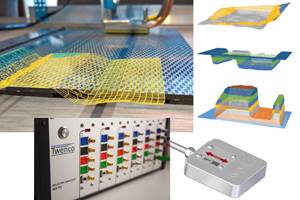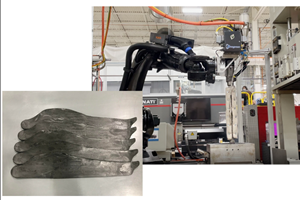Resin infusion processes
Ever-increasing demand for faster production rates has pressed the industry to replace hand layup with alternative fabrication processes and has encouraged fabricators to automate those processes wherever possible. A common alternative is resin transfer molding (RTM), sometimes referred to as liquid molding. RTM is a
Ever-increasing demand for faster production rates has pressed the industry to replace hand layup with alternative fabrication processes and has encouraged fabricators to automate those processes wherever possible.
A common alternative is resin transfer molding (RTM), sometimes referred to as liquid molding. RTM is a fairly simple process: It begins with a two-part, matched, closed mold, made of metal or composite material. Dry reinforcement (typically a preform) is placed into the mold, and the mold is closed. Resin and catalyst are metered and mixed in dispensing equipment, then pumped into the mold under low to moderate pressure through injection ports, following predesigned paths through the preform. Extremely low-viscosity resin is used in RTM applications for thick parts, to permeate preforms quickly and evenly before cure. Both mold and resin can be heated, as necessary, for particular applications. RTM produces parts that do not need to be autoclaved. However, once cured and demolded, a part destined for a high-temperature application usually undergoes postcure. Most RTM applications use a two-part epoxy formulation. The two parts are mixed just before they are injected. Bismaleimide and polyimide resins are also available in RTM formulations. "Light RTM"is a variant of RTM that is growing in popularity. Low injection pressure, coupled with vacuum, allow the use of less-expensive, lightweight two-part molds.
The benefits of RTM are impressive. Generally, dry preforms for RTM are less expensive than prepreg material and can be stored at room temperature. The process can produce thick, near-net shape parts, eliminating most post-fabrication work. It also yields dimensionally accurate complex parts with good surface detail and delivers a smooth finish on all exposed surfaces. It is possible to place inserts inside the preform before the mold is closed, allowing the RTM process to accommodate core materials and integrate "molded in"fittings and other hardware into the part structure during the molding process. Moreover, void content on RTM'd parts is low, measuring in the 0 to 2 percent range. Finally, RTM significantly cuts cycle times and can be adapted for use as one stage in an automated, repeatable manufacturing process for even greater efficiency, reducing cycle time from what can be several days, typical of hand layup, to just hours - or even minutes.
In contrast to RTM, where resin and catalyst are premixed prior to injection under pressure into the mold, reaction injection molding (RIM) injects a rapid-cure resin and a catalyst into the mold in two separate streams; mixing and the resultant chemical reaction both occur in the mold instead of in a dispensing head. Automotive industry suppliers combine structural RIM (SRIM) with rapid preforming methods to fabricate structural parts that don't require a Class A finish. Programmable robots have become a common means to spray a chopped fiberglass/binder combination onto a vacuum-equipped preform screen or mold. Robotic sprayup can be directed to control fiber orientation. A related technology, dry fiber placement, combines stitched preforms and RTM. Fiber volumes of up to 68 percent are possible, and automated controls ensure low voids and consistent preform reproduction, without the need for trimming.
Vacuum-assisted resin transfer molding (VARTM) refers to a variety of related processes, which represent the fastest growing new molding technology. The salient difference between VARTM-type processes and standard RTM is that in VARTM, resin is drawn into a preform through use of a vacuum, rather than pumped in under pressure. VARTM does not require high heat or pressure. For that reason, VARTM operates with low-cost tooling, making it possible to inexpensively produce large, complex parts in one shot.
In the VARTM process, fiber reinforcements are placed in a one-sided mold, and a cover (rigid or flexible) is placed over the top to form a vacuum-tight seal. The resin typically enters the structure through strategically placed ports. It is drawn by vacuum through the reinforcements by means of a series of designed-in channels that facilitate wetout of the fibers. Fiber content in the finished part can run as high as 70 percent. Current applications include marine, ground transportation and infrastructure parts.
Resin film infusion (RFI) is a hybrid process in which a dry preform is placed in a mold on top of a layer or interleaved with layers of high-viscosity resin film. Under applied heat, vacuum and pressure, the resin is drawn into the preform, resulting in uniform resin distribution, even with high-viscosity, toughened resins, because of the short flow distance.
Related Content
ASCEND program update: Designing next-gen, high-rate auto and aerospace composites
GKN Aerospace, McLaren Automotive and U.K.-based partners share goals and progress aiming at high-rate, Industry 4.0-enabled, sustainable materials and processes.
Read MoreJEC World 2023 highlights: Innovative prepregs, bio-resins, automation, business development
CW’s Jeff Sloan checks in with JEC innovations from Solvay, A&P, Nikkiso, Voith, Hexcel, KraussMaffei, FILL, Web Industries, Sicomin, Bakelite Synthetics, Westlake Epoxy and Reliance Industries.
Read MoreTwenco develops sensors for smart molds and process control in resin infusion and composites welding
Non-invasive DEA and NDT Analyzer for multi-parameter monitoring, QA and control, including real time simulation feed and 3D process visualization across and through composite parts.
Read MoreLow-void, large-scale, high-volume 3D-printed composites
Among its many composites-related projects, Oak Ridge National Laboratory recently installed its first AMCM test cell, combining extrusion with compression molding for fast, low-void, low-porosity thermoplastic composite parts.
Read MoreRead Next
From the CW Archives: The tale of the thermoplastic cryotank
In 2006, guest columnist Bob Hartunian related the story of his efforts two decades prior, while at McDonnell Douglas, to develop a thermoplastic composite crytank for hydrogen storage. He learned a lot of lessons.
Read MoreCW’s 2024 Top Shops survey offers new approach to benchmarking
Respondents that complete the survey by April 30, 2024, have the chance to be recognized as an honoree.
Read MoreComposites end markets: Energy (2024)
Composites are used widely in oil/gas, wind and other renewable energy applications. Despite market challenges, growth potential and innovation for composites continue.
Read More






















